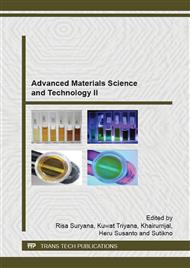p.73
p.78
p.84
p.88
p.92
p.96
p.100
p.104
p.109
Poly(aniline-co-m-aminobenzoic acid): A Novel Ester Vapor Sensor and its Thin Film Deposition on Silane Functionalized SAM Glass Surface
Abstract:
In recent years, a great deal of attention has been paid on coating the surface of glass and related inorganic substrate with a layer of polymers having special properties to prepare various functional materials. On a smooth surface of glass, the adhesion of a conductive polymer is generally poor. The increase of the surface adhesion was achieved through a chemical pre-treatment. One of the method is to generate a self-assembly monolayer or patterned SAM monolayer to increase the surface adhesion property of glass surface towards polymer solutions [1,2]. Self-assembled monolayers (SAMs) are monomolecular layers which are spontaneously formed upon immersing a solid substrate into a solution containing functional molecules. SAMs can be prepared using different types of molecules and different substrates. Aminosilanes such as (3-Aminopropyl)-triethoxysilane (APTES) are attractive for such applications [3]. Particularly, aminosilanes have the advantage of catalytic activity by the amine group that facilitates formation of siloxane bonds with surface silanols. In present study, a 3-step procedure for the introduction of APTES on glass pieces is described. After chemisorptions of APTES, poly (aniline-co-m-aminobenzoic acid) synthesised by inverse emulsion polymersation route was coated on to the functionalised glass surface in the form of a solution prepared in DMSO. The modified glass was characterized mainly by IR spectroscopy and contact angle measurement. The coated glass was used for ester sensing.
Info:
Periodical:
Pages:
92-95
Citation:
Online since:
August 2015
Authors:
Price:
Сopyright:
© 2015 Trans Tech Publications Ltd. All Rights Reserved
Share:
Citation:


